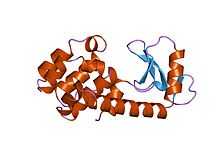Brian Matthews (biochemist)
| Brian W. Matthews | |
|---|---|
| Born |
1938 (age 76–77)[1] Mount Barker, South Australia |
| Institutions | |
| Alma mater | University of Adelaide |
| Known for | |
|
Website molbio | |

Brian W. Matthews is a biochemist and biophysicist educated at the University of Adelaide, contributor to x-ray crystallographic methodology[3] at the University of Cambridge, and since 1970 at the University of Oregon as Professor of Physics and HHMI investigator in the Institute of Molecular Biology.
He created hundreds of mutants of T4 lysozyme (making it the commonest structure in the PDB), determined their structure by x-ray crystallography and measured their melting temperatures. Starting from questions about the basis of "temperature-sensitive" mutations,[4] his work has explicated much about the general energetic and structural effects of mutations in proteins.[5] He also solved early structures of the thermophilic bacterial enzyme thermolysin,[6] the helix-turn-helix DNA-binding transcription factor lambda Cro repressor,[7] and the light-antenna bacteriochlorophyll protein.[8]
Beyond his contributions to biochemistry, Matthews is also known in the machine learning community for the Matthews correlation coefficient, which he introduced in a paper in 1975.[2] The coefficient is used as a measure of the quality of binary (two-class) classifications.
Matthews has been a member of the National Academy of Sciences since 1986. He is the editor of the scientific journal Protein Science.
References
- ↑ Kresge, Nicole; Simoni, Robert D.; Hill, Robert L. (2009). "Structural Studies of Thermolysin: the Work of Brian W. Matthews". The Journal of Biological Chemistry 284 (26): e8–e9.
- ↑ 2.0 2.1 Matthews, B. W. (1975). "Comparison of the predicted and observed secondary structure of T4 phage lysozyme". Biochimica et Biophysica Acta (BBA) - Protein Structure 405 (2): 442–451. doi:10.1016/0005-2795(75)90109-9.
- ↑ ,Matthews BW (1966). "The determination of the position of anomalously scattering heavy atom groups in protein crystals". Acta Crystallographica 20: 230–239. doi:10.1107/S0365110X6600046X.
- ↑ Matthews BW, Remington SJ (1974). "The three dimensional structure of the lysozyme from bacteriophage T4". Proc. Nat. Acad. Sci. USA 71: 4178–4182. doi:10.1073/pnas.71.10.4178.
- ↑ Baase WA, Liu L, Tronrud DE, Matthews BW (2010). "Lessons from the lysozyme of phage T4". Protein Science 19 (4): 631–41. doi:10.1002/pro.344. PMC 2867005. PMID 20095051.
- ↑ Matthews BW, Colman PM, Jansonius JN, Titani K, Walsh KA, Neurath H (1972). "Structure of thermolysin". Nature New Biology 238 (80): 41. doi:10.1038/newbio238041a0.
- ↑ Anderson WF, Ohlendorf DH, Takeda Y, Matthews BW (1981). "Structure of the cro repressor from bacteriophage λ and its interaction with DNA". Nature 290 (5809): 754–758. doi:10.1038/290754a0. PMID 6452580.
- ↑ Fenna RE, Matthews BW (1975). "Chlorophyll arrangement in a bacteriochlorophyll protein from Chlorobium limicola". Nature 258: 573. doi:10.1038/258573a0.
External links
- Brian Matthews at The Institute of Molecular Biology at the University of Oregon
- HHMI Alumni Scientists
- Molecule of the Month: Lysozyme